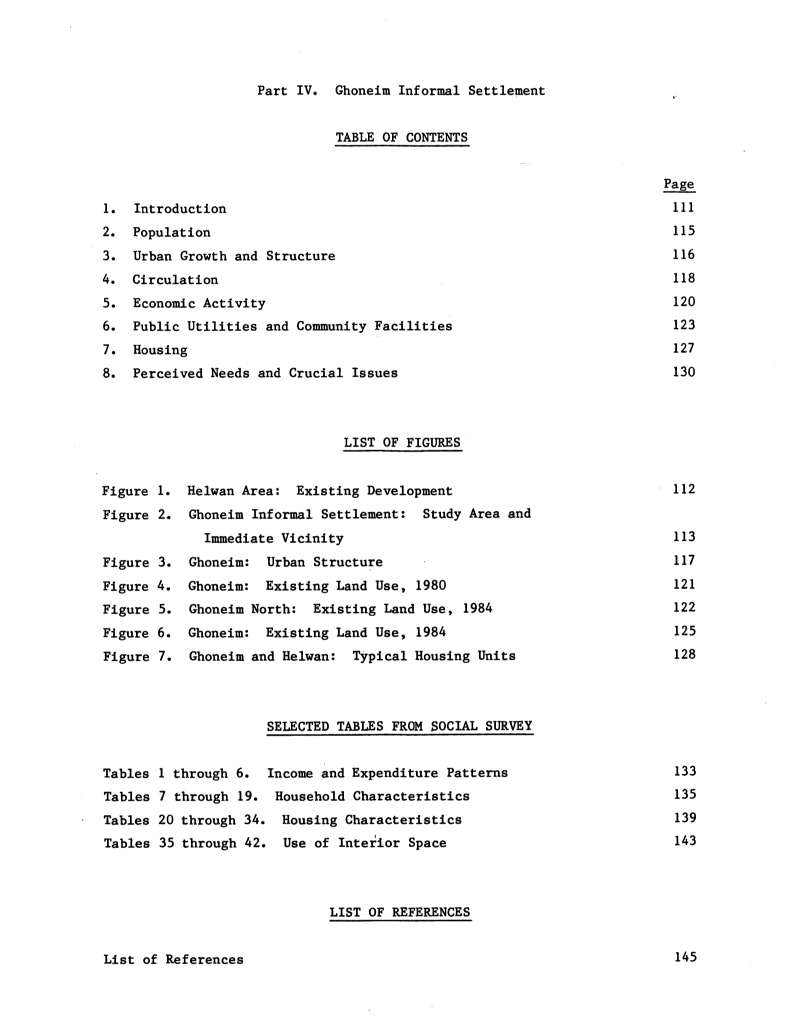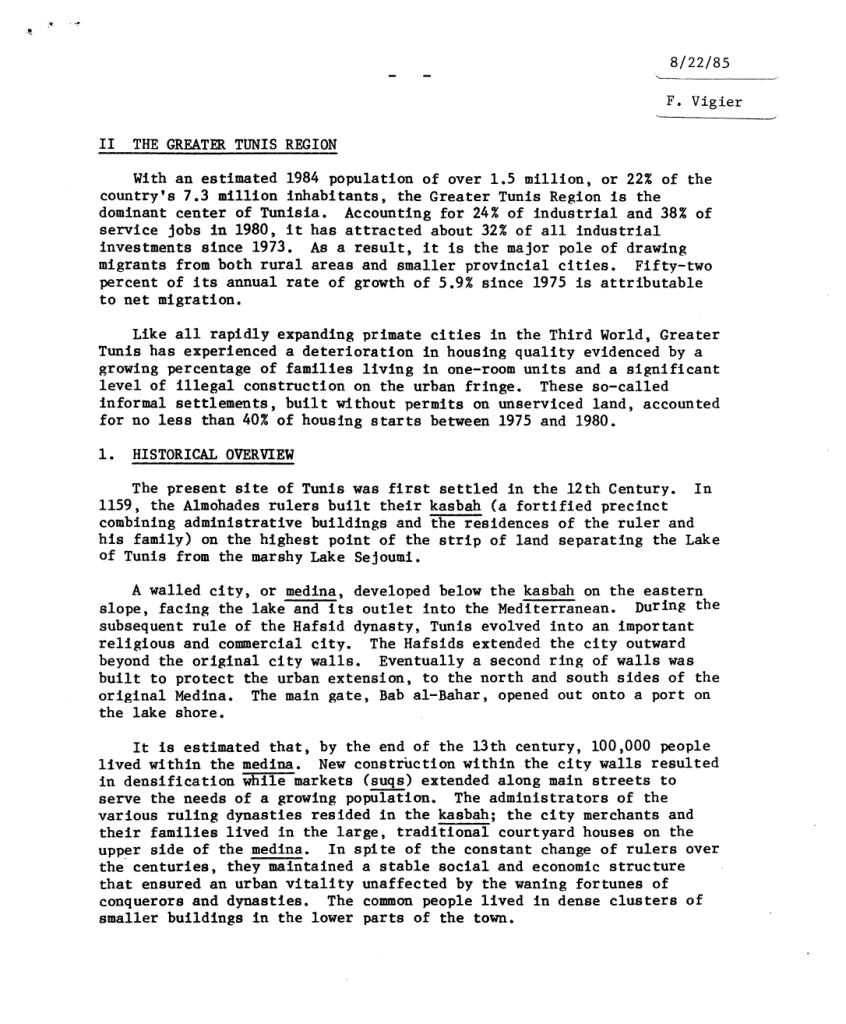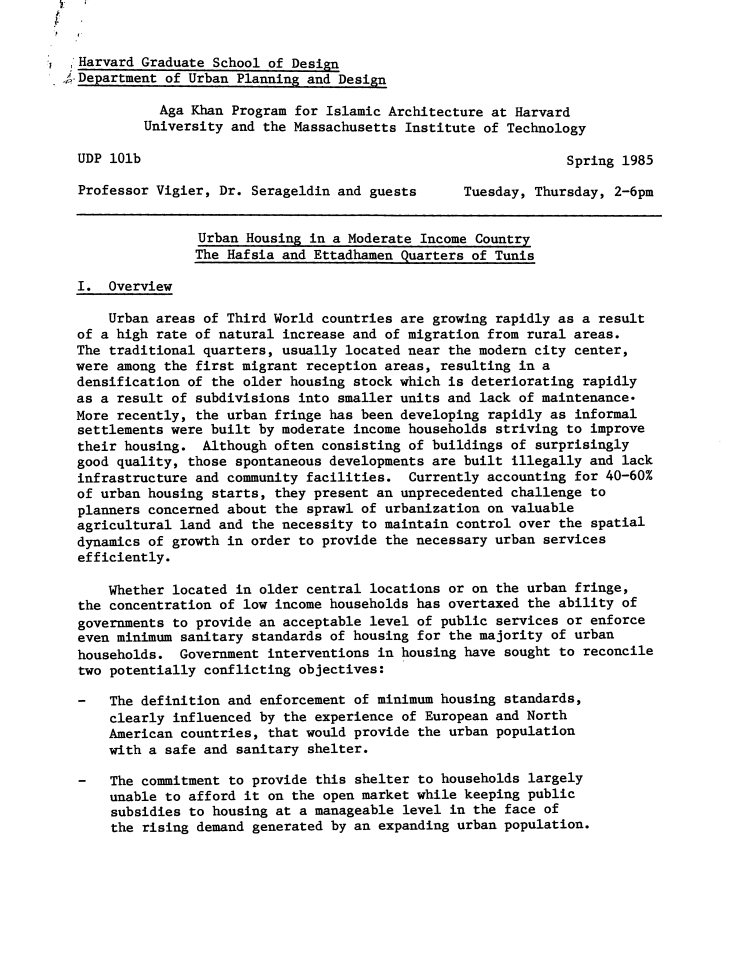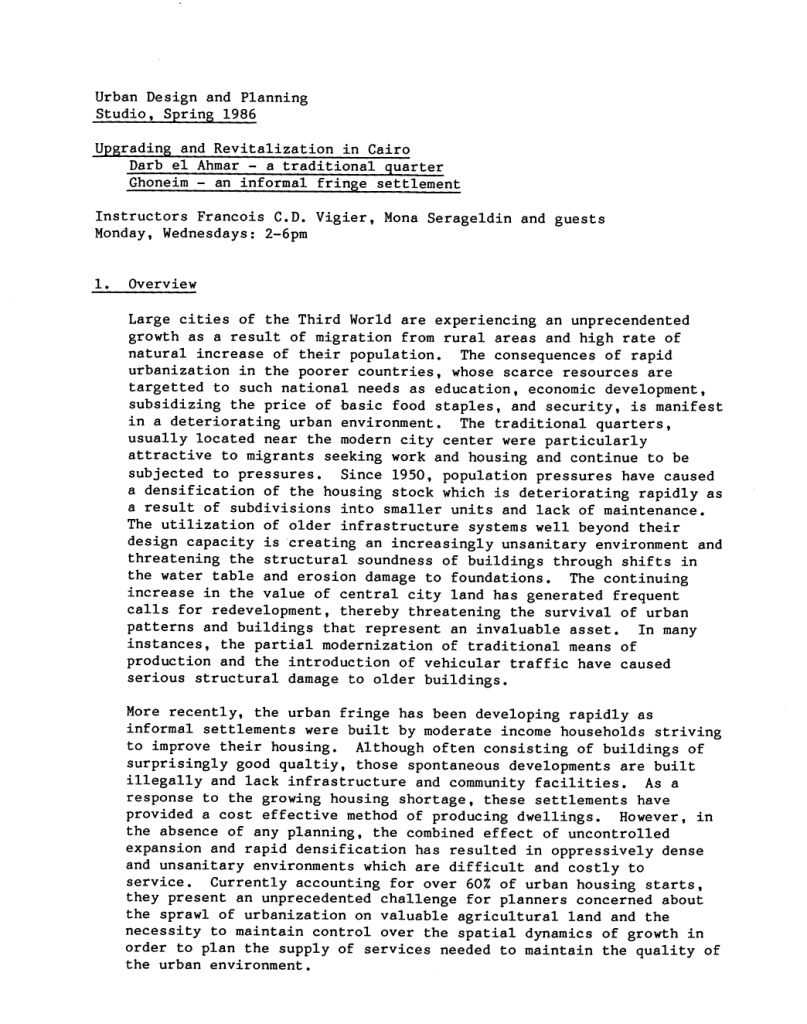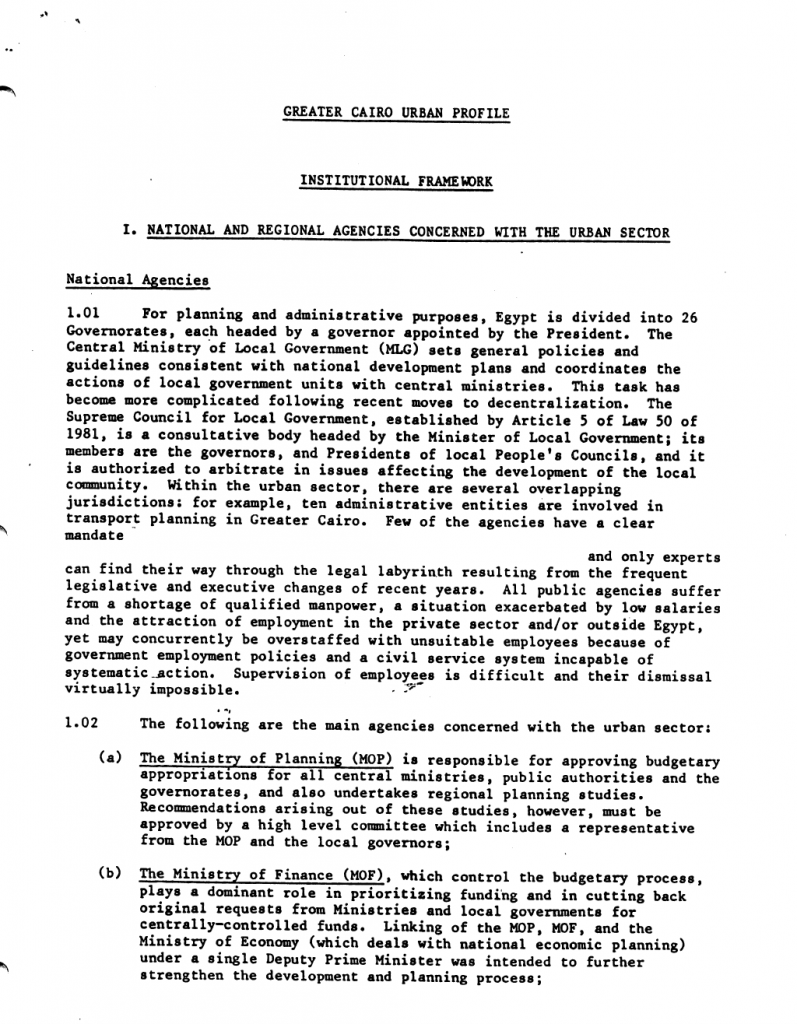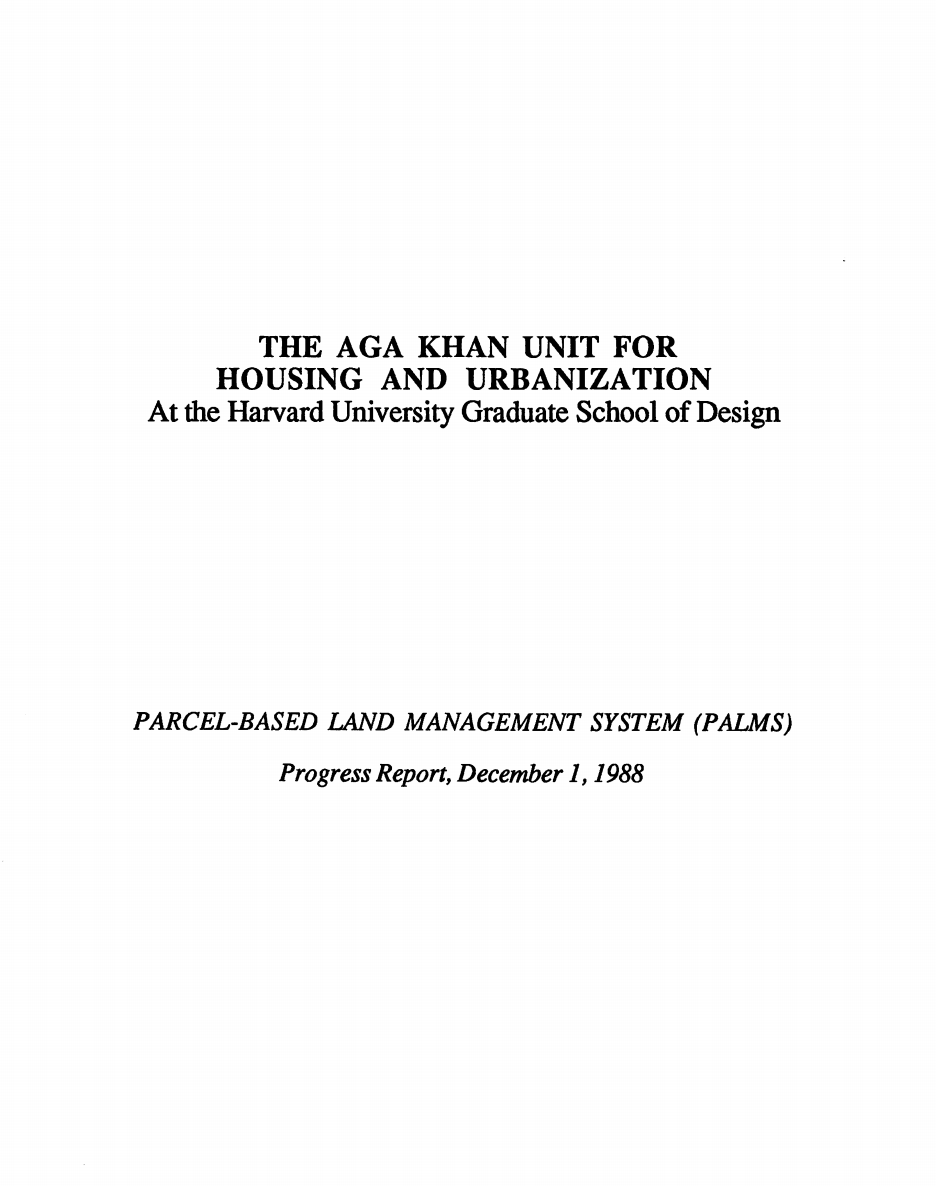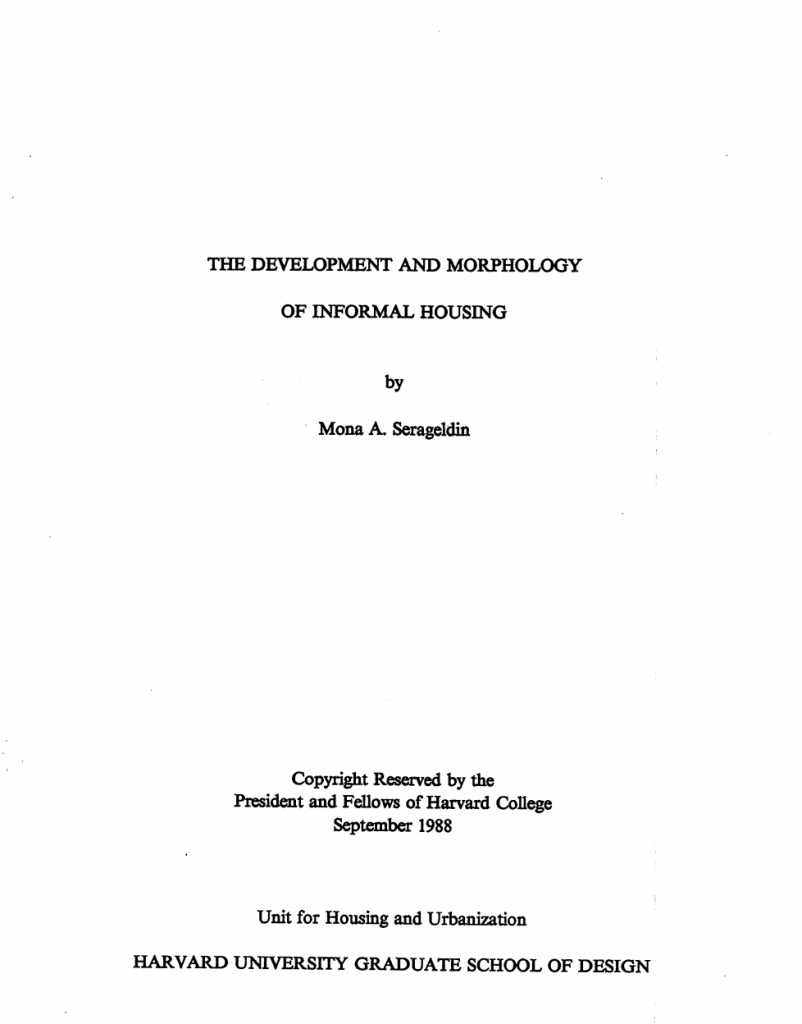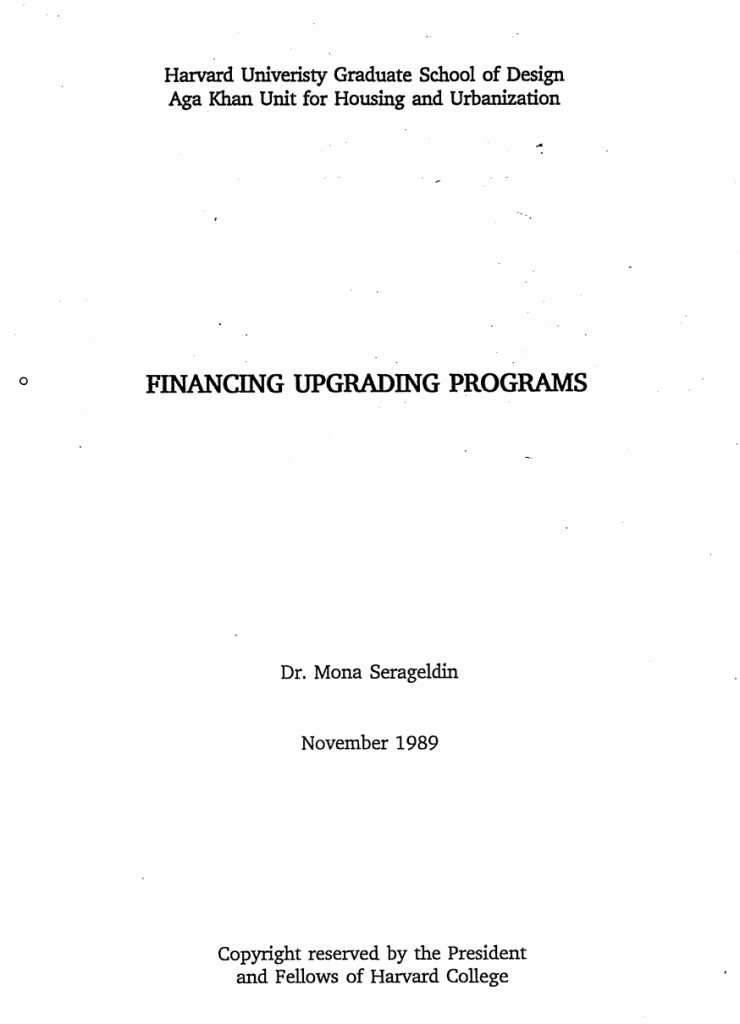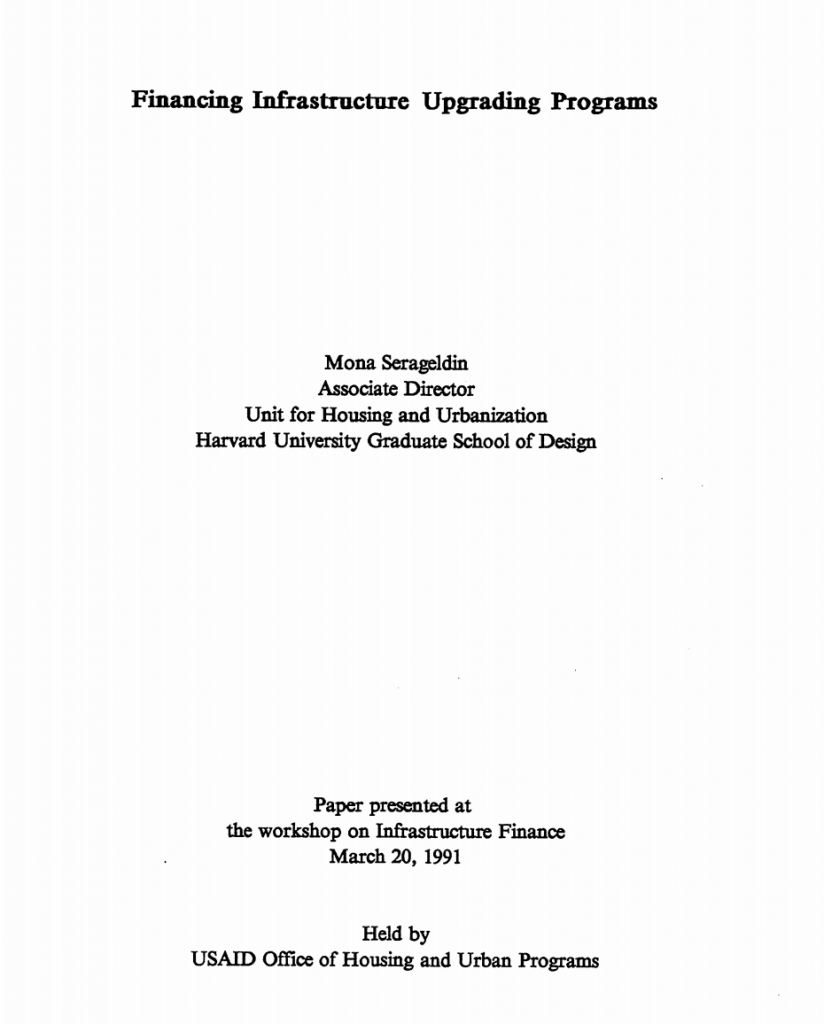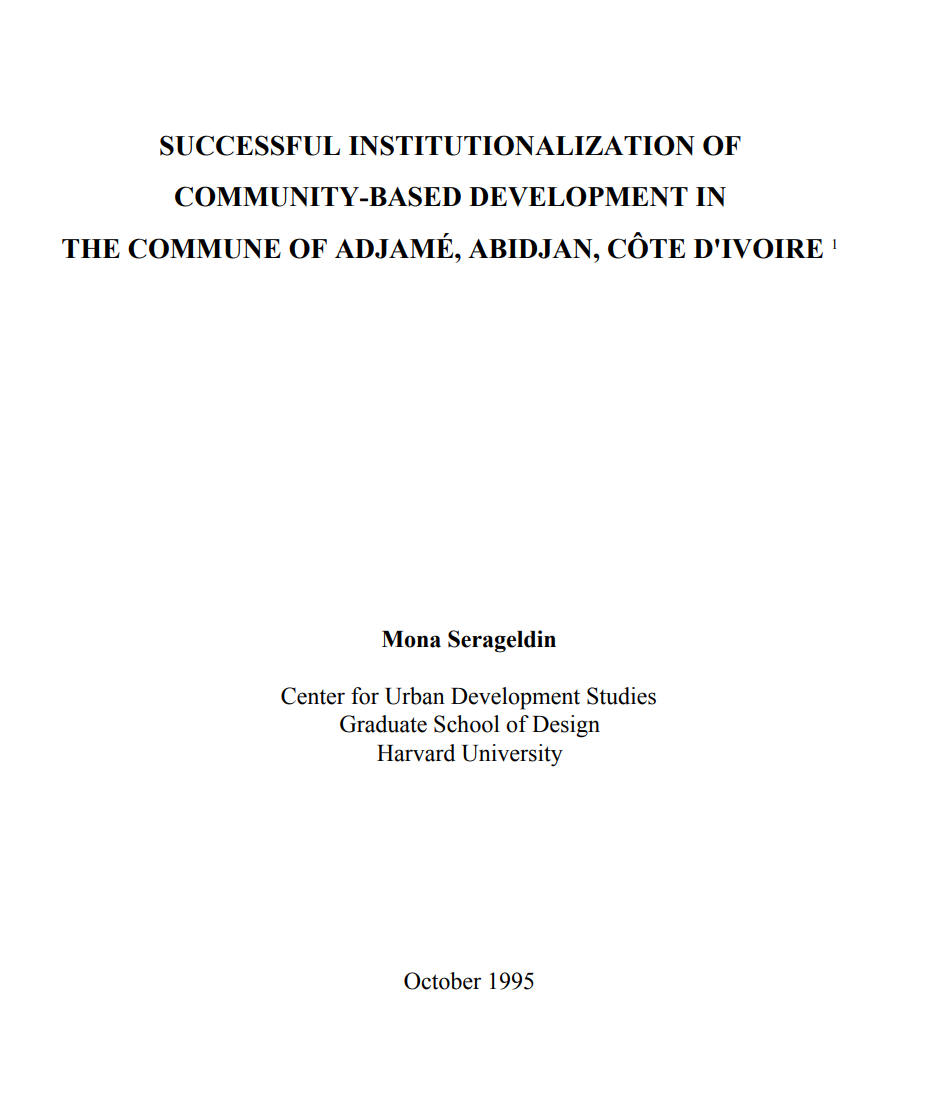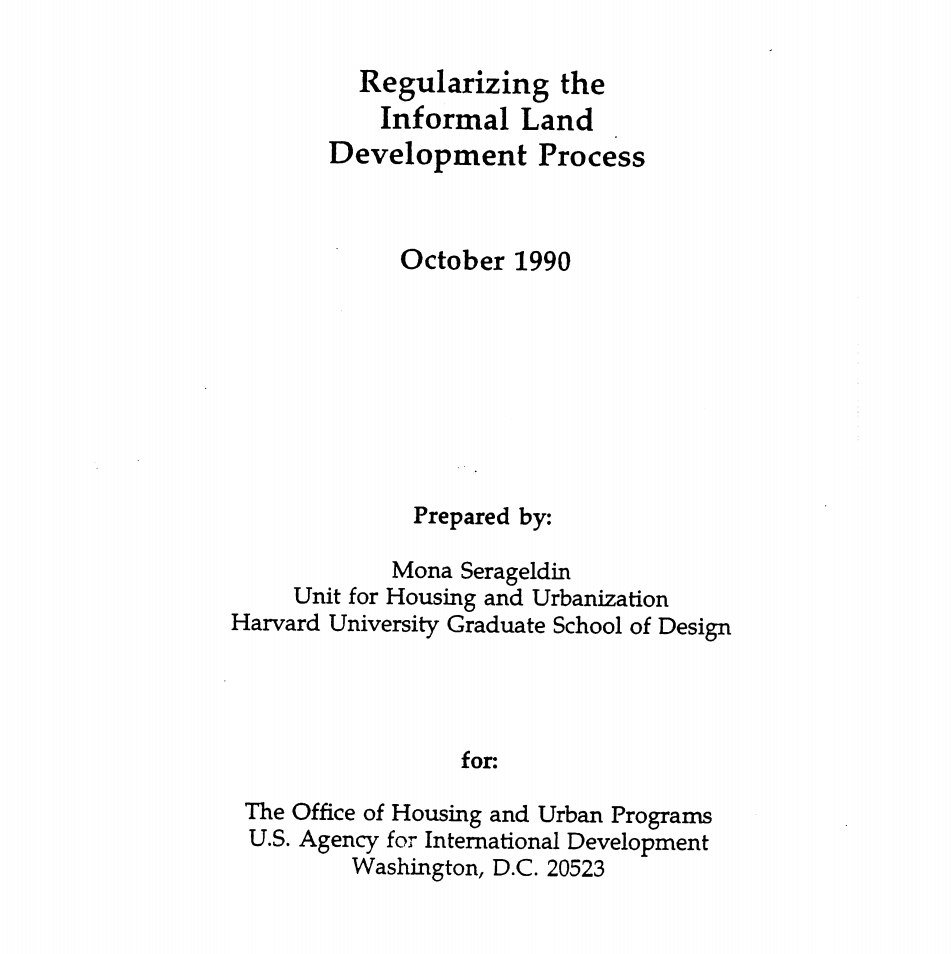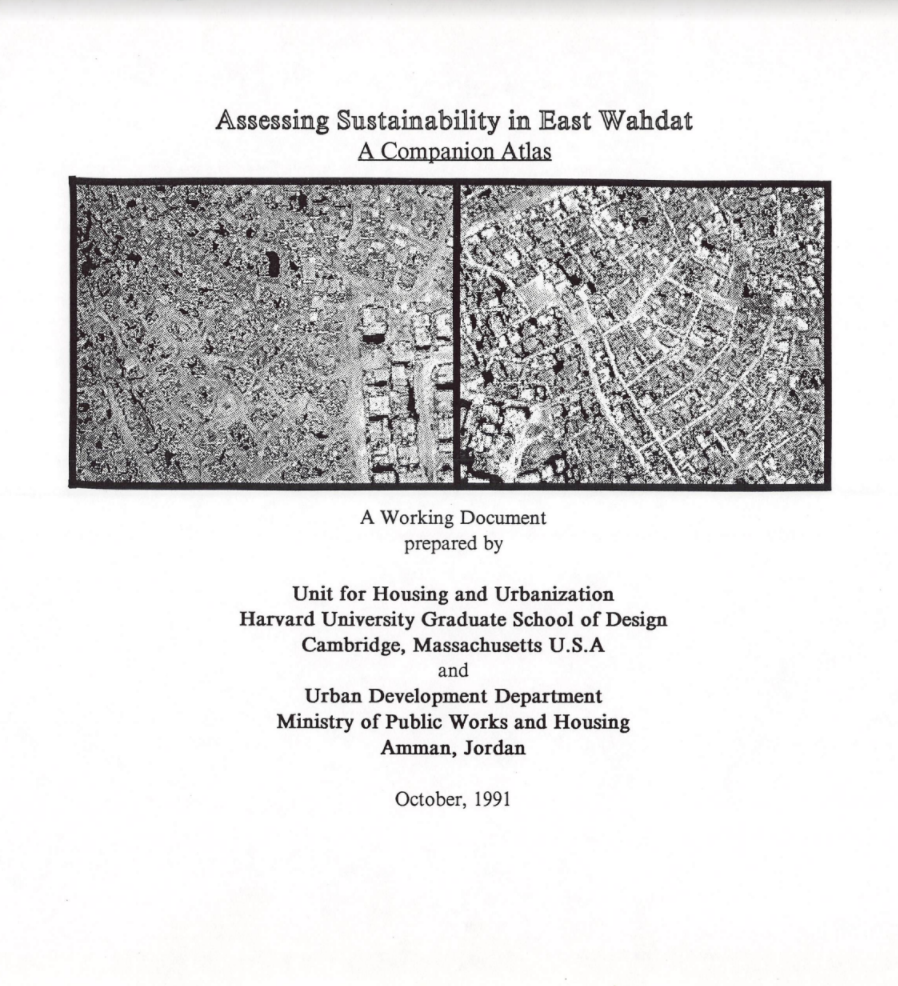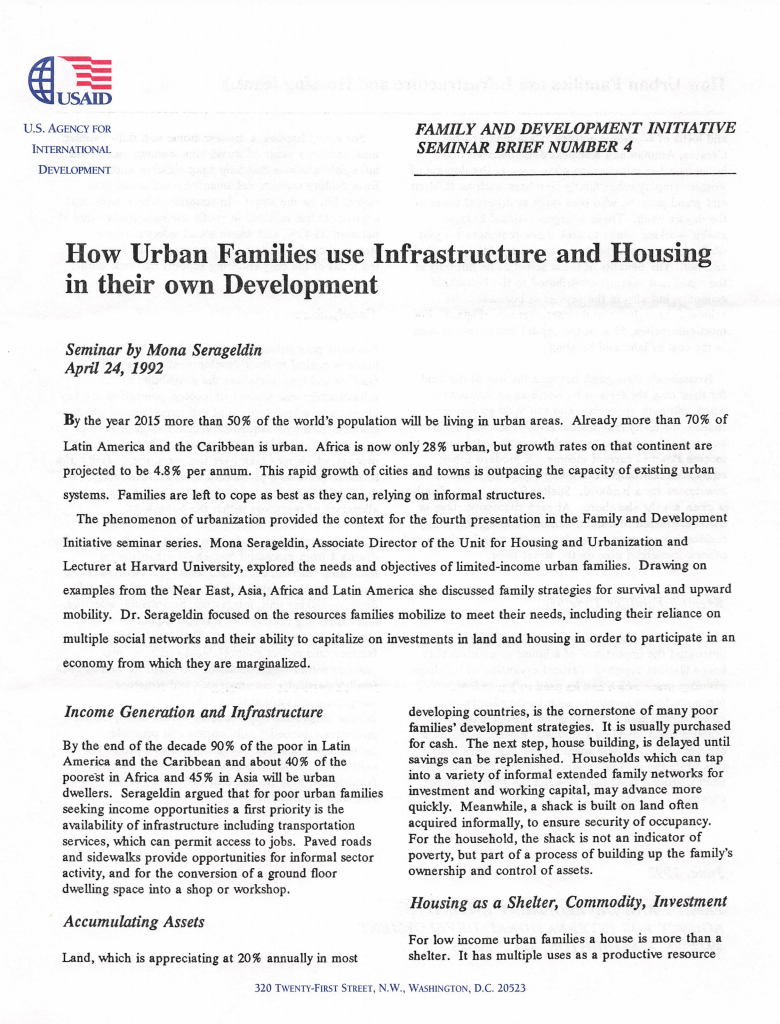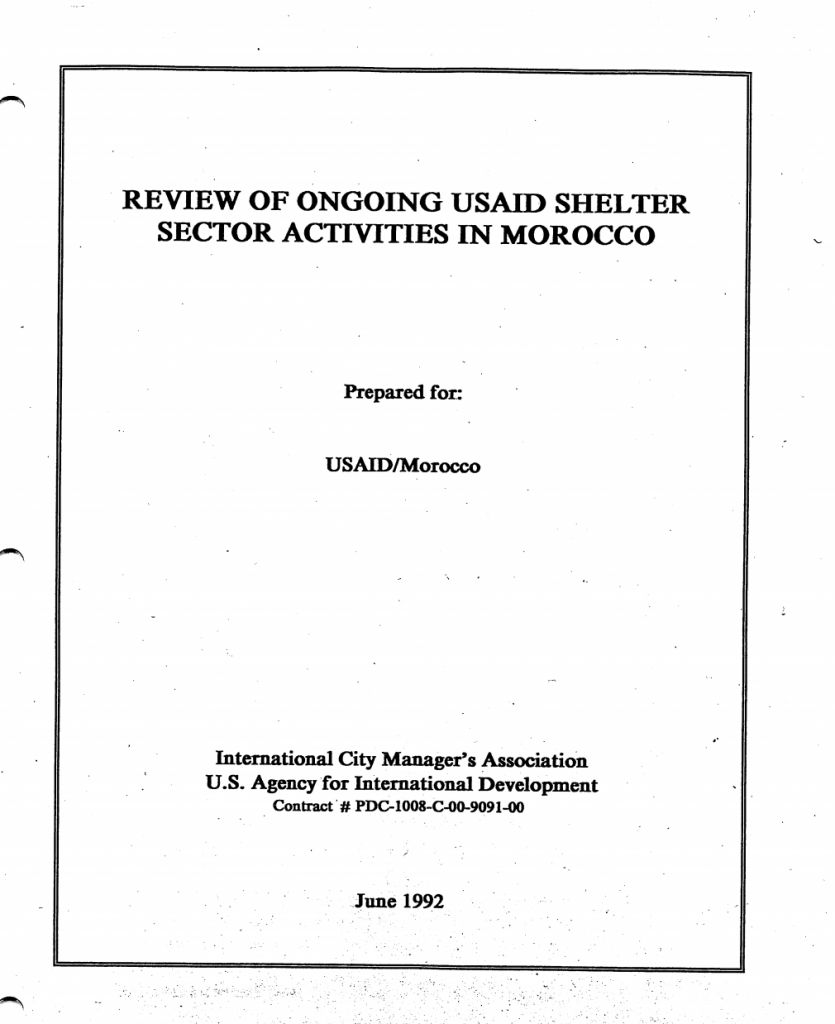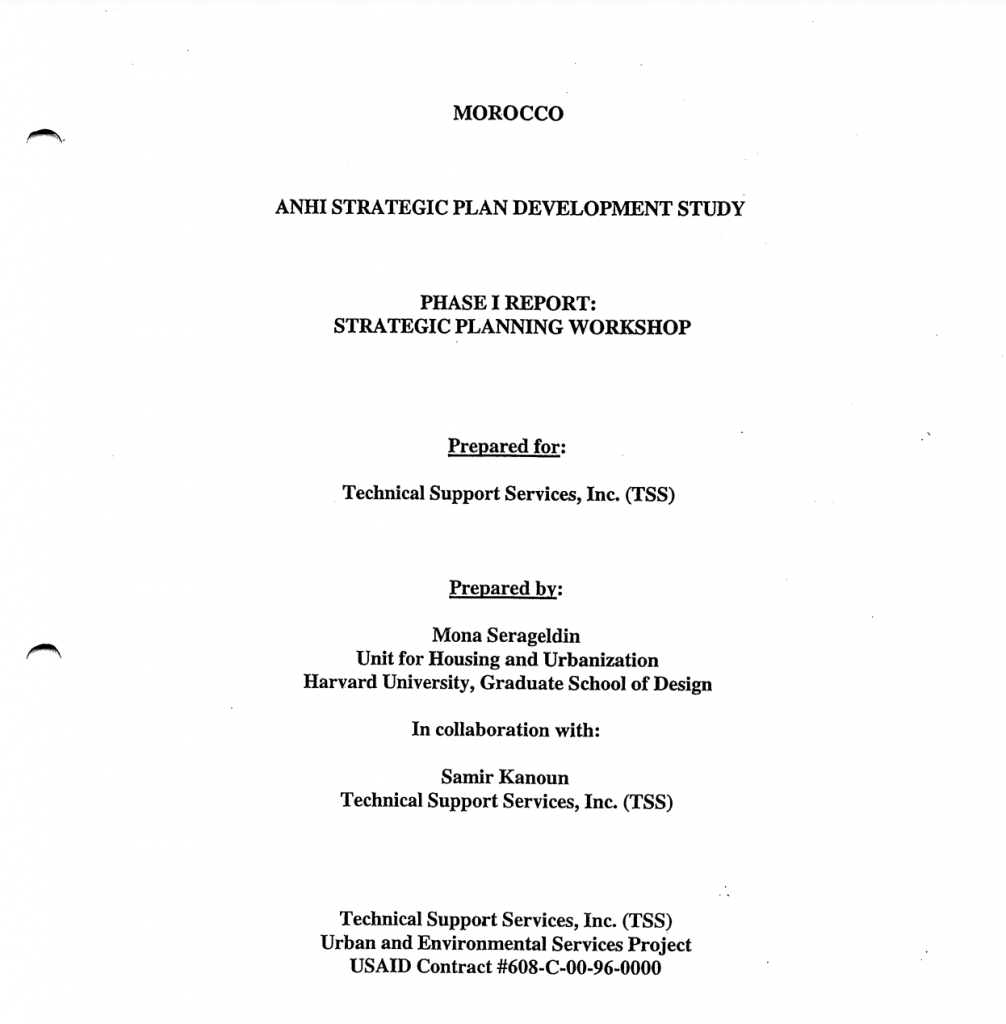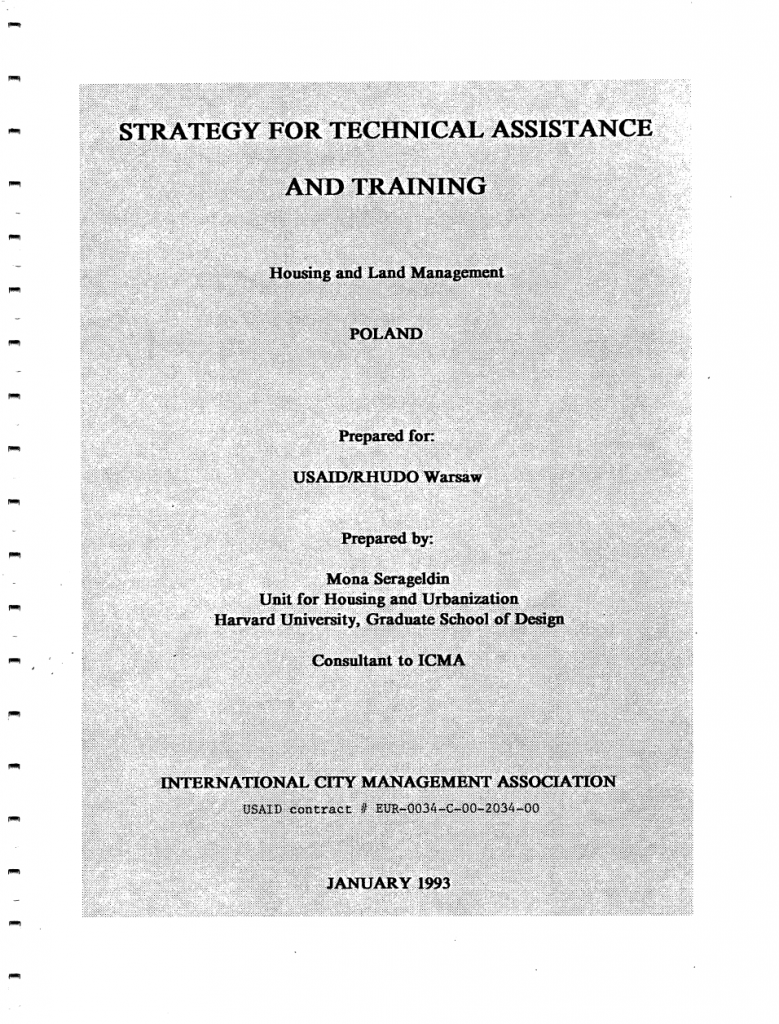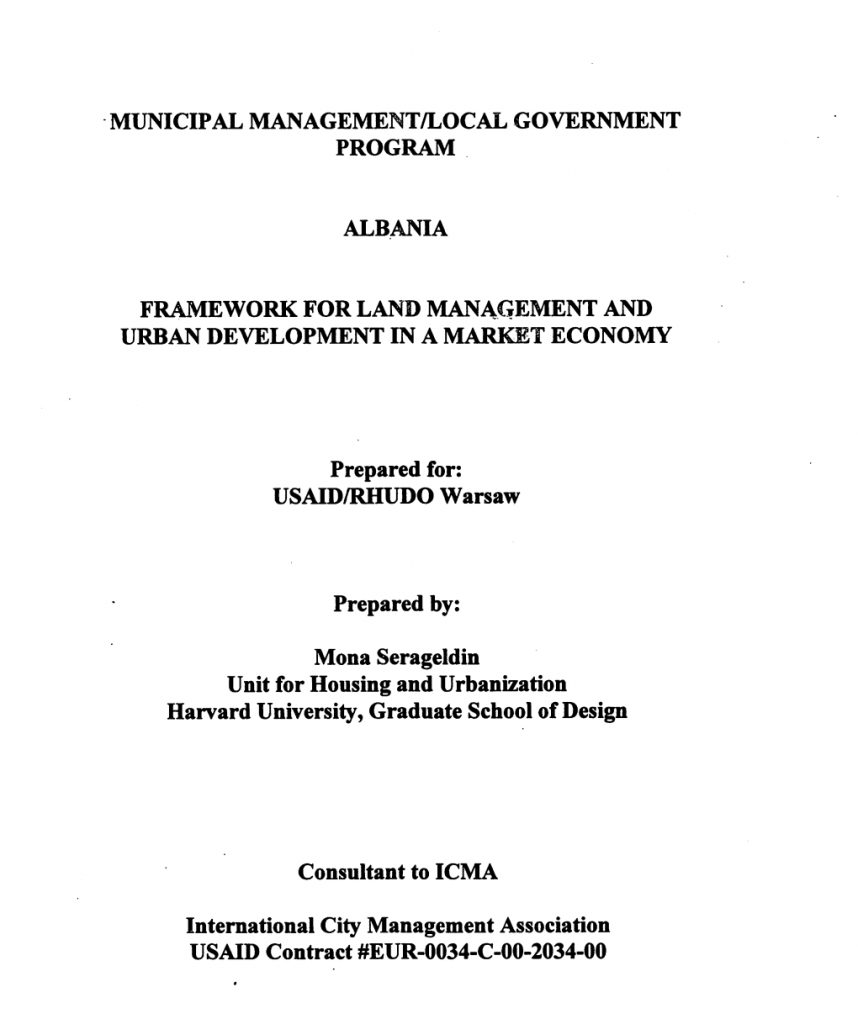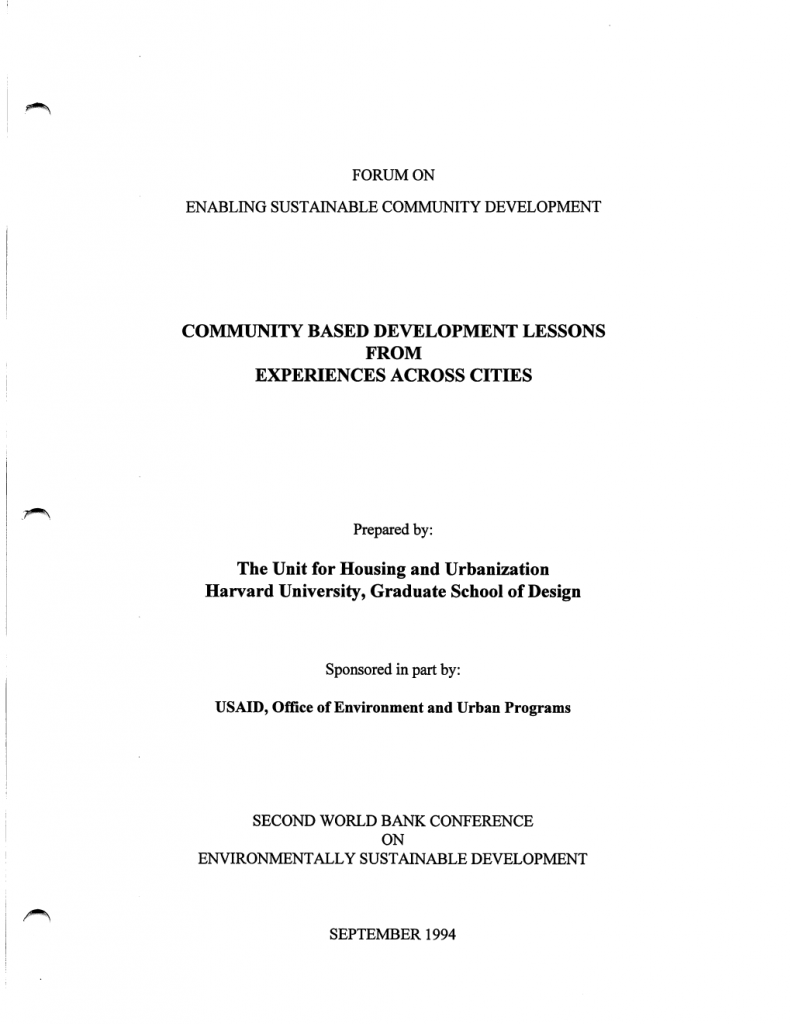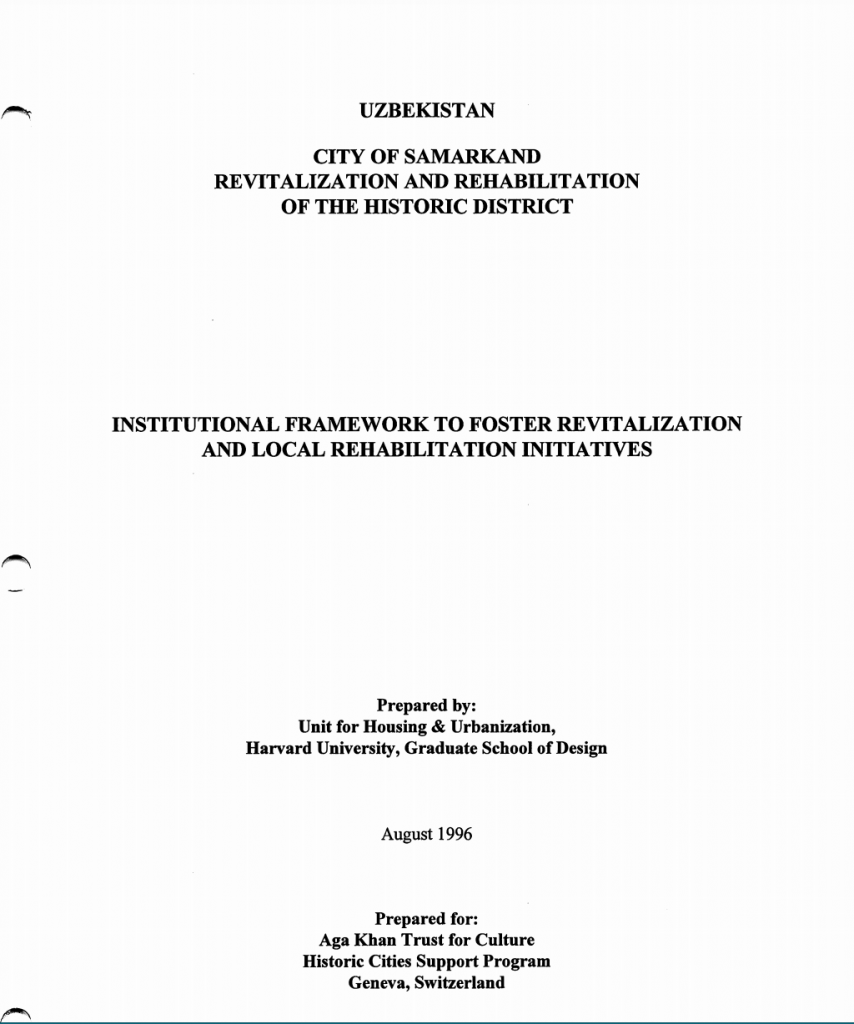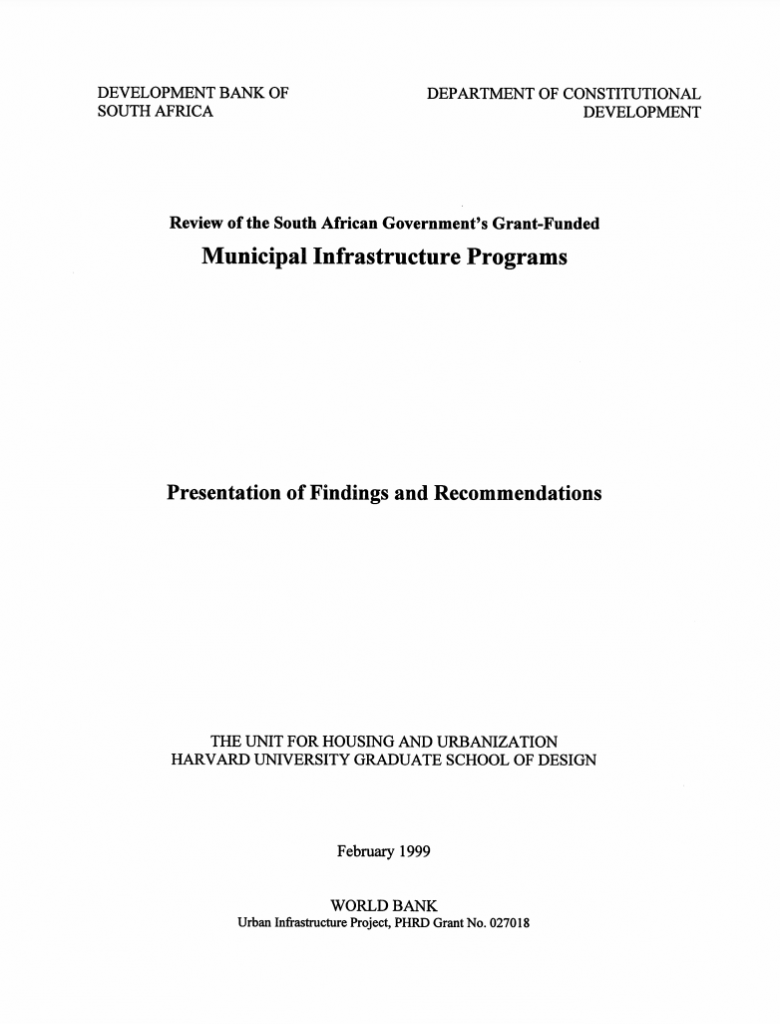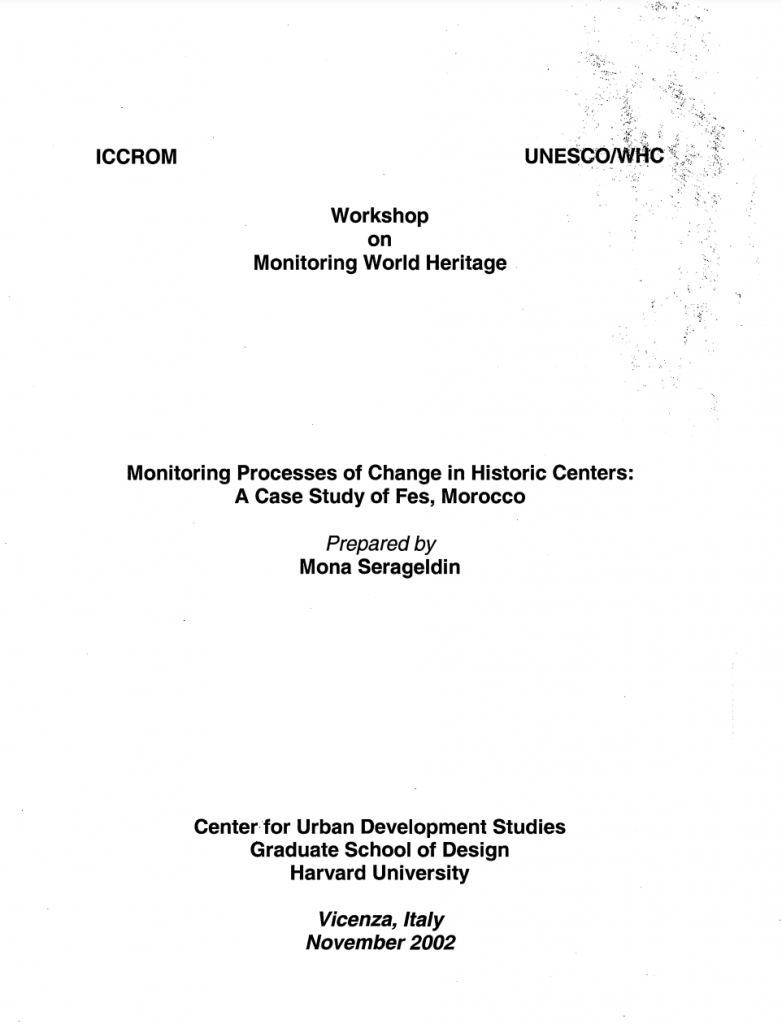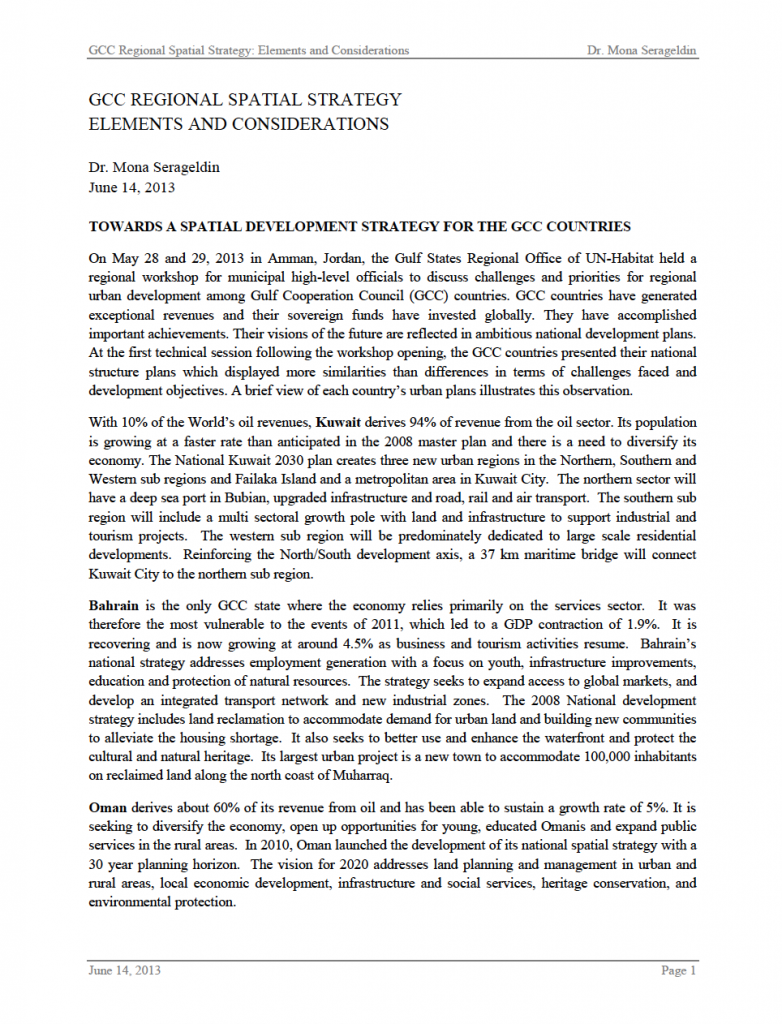MSDA // DOCUMENTS
1984-2013
A digitized excerpt from the archive of Dr. Mona Serageldin, founding member of I2UD and Vice President from 2005-2018
The MSDA Document Collection complements the research materials in the I2UD Digital Library, acknowledging the rich, cooperative, work history linking I2UD and Mona Serageldin’s collections.
Serageldin’s research has been internationally recognized for her contributions to urban studies. In 2018, Mona was posthumously awarded an UN-Habitat Scroll of Honour for promoting practical research-based approaches to address a broad spectrum of development challenges in a wide range of settings. View UN-Habitat’s press bulletin from September 28, 2018.
‣ For an overview of Mona Serageldin’s career, see the Founders page of the main I2UD website.
The MSDA Document Collection contains:
- Reports
- Site surveys
- Assessments
- Urban evaluations
- Academic and research materials
‣ Select document titles or thumbnails to view PDFs.
‣ Cross-referenced materials can be found in the I2UD Digital Library and the MSDA Photograph Collection.
Document Index
Jump to…
- 1984 “Ghoneim: An Informal Settlement in the Helwan Area”
- 1985 “The Greater Tunis Region”
- 1985 “Urban Housing in a Moderate Income Country: The Hafsia and Ettadhamen Quarters of Tunis”
- 1986 “Upgrading and Revitalization in Cairo: Darb el Ahmar and Ghoneim”
- 1986 “Greater Cairo Urban Profile: Institutional Framework”
- 1987 “A New Town in Bahrain”
- 1987-1993 “Computerized Urban Management Methods: PROJECT, AFFORD, and PALMS”
- 1988 “Cairo: The Darb Al Ahmar; The Southern Sector”
- 1988 “The Development and Morphology of Informal Housing”
- 1989-1991 “Financing Upgrading Programs”
- 1990 “Successful Institutionalization of Community Based Development,” Adjamé, Abidjan, Côte d’Ivoire
- 1990 “Regularizing the Informal Land Development Process”
- 1991 “Accessing Sustainability in East Wahdat: A Companion Atlas”
- 1992-1993 Document 1 – “How Urban Families Use Infrastructure and Housing in Their Own Development,” Seminar Brief
- 1992-1993 Document 2 – “The Use of Land and Infrastructure in the Self-Improvement Strategies of Urban Lower Income Families”
- 1992-1998 Document 1 – “Review of Ongoing USAID Shelter Sector Activities in Morocco”
- 1992-1998 Document 2 – “Morocco: ANHI Strategic Plan Development Study”
- 1993 “Strategy for Technical Assistance and Training: Housing and Land Management,” Poland
- 1994 “Report Framework for Land Management and Urban Development in a Market Economy,” Albania
- 1994 “Community Based Development Lessons from Experience Across Cities”
- 1995 “Initiating Neighborhood Partnerships in Poland”
- 1996 “City of Samarkand: Revitalization and Rehabilitation of the Historic District”
- 1998-1999 Document 1 – Review of South African Municipal Infrastructure Programs, Letter of Interest
- 1998-1999 Document 2 – “Municipal Infrastructure Programs: Presentation of Findings and Recommendations”
- 2002 “Monitoring Processes of Change in Historic Centers: A Case Study of Fes, Morocco”
- 2013 “GCC Regional Spatial Strategy Elements and Considerations”
Copyright and Use Information
Document citations: Author(s). “Document Title.” Document Date. Mona Serageldin Digital Archive, Institute for International Urban Development. Date Accessed. Document URL.
1984
“Ghoneim: An Informal Settlement in the Helwan Area”
Mona Serageldin, 1984
A 1984 site survey of the Ghoneim informal settlement region and community experience, as researched and compiled by Serageldin. The document details population characteristics for Ghoneim, covering urban growth and structure, space use and circulation, economic activity, public utilities, community facilities, and crucial housing needs and for the Ghoneim Informal settlement located in the Helwan municipal region outside Cairo, Egypt.
Figures and maps depict Helwan area, with “existing development” from 1984 and earlier. Includes views of the Ghoneim study area, immediate vicinity, urban structures, existing land use from 1980 and 1984, and typical housing units.
Tables 1 to 42 illustrate results from a social survey given to Ghoneim’s residents, detailing income and expenditure patterns; household characteristics; housing characteristics; and use of interior space.
Citation: Serageldin, Mona. “Part IV. Ghoneim: An Informal Settlement in the Helwan Area,” 1984. HU-GSD Urban Design Seminar materials.
Related: Urban Design and Planning Studio, Spring 1986: “Upgrading and Revitalization in Cairo: Darb el Ahmar, a traditional quarter; Ghoneim, an informal fringe settlement.”
See also: Photography of Ghoneim’s inhabitants: Ghoneim Informal Settlements – I2UD Photograph Collection;
“Cairo – Urban Fringe and Informal Housing Settlements, Helwan Governorate, Egypt,” 1970-1985 – MSDA M01 Galleries 1-10.
1985
“The Greater Tunis Region”
Francois Vigier, August 1985
An overview of urban development in Tunis, Tunisia, authored by Francois Vigier in August 1985, describing the Greater Tunis region of Tunisia, then the dominant urban center of the country. The document is divided into four sections: Historical Overview; Recent Developments; Current Conditions in the Medina; and Development of the Urban Fringe:
1. Historical Overview, describing the regional history from the pre-Turkish period into the 1980s, describing the city as a European trading crossroads.
1.1 Urban Morphology of the Traditional City, detailing the “dense coherent urban architecture, punctured by the repetitive pattern of courtyards,” comprised of warehouses, street hierarchies, primary circulation systems, residential quarters, social order and privacy, and residential neighborhood clusters.
1.2 The Western City (La Ville Neuve), a reconfiguration of Tunis’s port to accommodate European ship passage, development of Tunis from 1900 onward, destruction of old city by the French, 20th century dynamics between modern and traditional sectors, and development of “gourbivilles” squatter settlements.
1.3 The Post-Independence Period, Discusses changes to Ville Neuve post 1956, and the building of a “modern central business district” in Tunis.
2. Recent Development Trends (Economic Aspects, Population and Income) detailing the stratification of contemporary urban society based on economic, cultural and divisions. Details the Tunis Urban Development Plan (1976-7), and accounts municipal hierarchy responsible for planning for the provision of public services, like water, sewage, electrical power, cooking fuel (butane), and waste disposal services.)
3. Current Conditions in the Medina, detailing Physical Characteristics and architecture of “housing stock” and historic buildings suffering neglect and deterioration.
4. Development of the Urban Fringe, tracking “spontaneous development” of urban and urban fringe regions in the modern era. Rise of gourbivilles, construction details, costs and trends between 1970s and 1980s.
Citation: Vigier Francois, “The Greater Tunis Region,” August 22, 1985. HU-GSD Urban Design Seminar materials.
Related: UN-Habitat State of Arab Cities 2012 Report, including collaboration by the Institute – I2UD Digital Library
See also: Tunis, Tunisia, 1978-1990 – I2UD Photograph Collection
1985
“Urban Housing in a Moderate Income Country: The Hafsia and Ettadhamen Quarters of Tunis,” Urban Design and Planning Studio
Drs. Francois Vigier and Mona Serageldin, Spring 1985
“Urban Housing in a Moderate Income Country: The Hafsia and Ettadhamen Quarters of Tunis” was the Spring 1985 GSD Studio seminar, hosted jointly by the Aga Khan Program for Islamic Architecture at Harvard University, and the Massachusetts Institute of Technology, and instructed by François Vigier and Mona Serageldin, with guest lecturers. The seminar introduced two traditional housing quarters in Tunisia: Hafsia, a low-income quarter in medieval Islamic Medina of Tunis, and Ettadhamen, an informal settlement on the urban fringe 7.5km from the city center.
In 1985, both communities were undergoing rapid urbanization and maintained populations of low-income households. Referring to the Tunisia housing development experience between 1950 to 1980, the report evaluated a number of “deleterious consequences” wrought by the failures of western-style public housing projects:
“The experience of the past thirty years has shown that the construction of western style public housing projects had had a number of deleterious consequences. They have proved to be expensive to build and maintain, slow to the develop, aesthetically disturbing, and their design is generally deemed to be culturally unsuitable for the poor. Their high cost was not affordable to the limited income households for which they were intended without a level of subsidation that created an unacceptable drain on the national budget. Middle-income groups were the main beneficiaries of public housing while the majority of the poor could not be reached. Slums and informal settlements continued to proliferate” (p. 2).
For the Hafsia medieval quarter, the seminar presented a model formulating a “comprehensive housing approach” for government programs to:
“a) Arrest the accelerating deterioration of the older urban core.
b) Revitalize and integrate traditional quarters into modern urban fabric.
c) Recognize and conserve the distinctive character of the Medina and preserve its historical and cultural legacy” (p. 3).
For the Ettadhamen informal settlement, the objectives were:
“a) To improve the urban environment in order to prevent the area from deteriorating into a slum as it densifies.
b) To provide needed community facilities.
c) To test alternative housing arrangements — shells, expandable cores, multi-family structures — to demonstrate the technical and functional feasibility of culturally sensitive design.
d) To develop a program which capitalizes on potential resources of the local community” (p. 5).
The document includes class topics and guest lecturer lists. Lecturers contributed “cultural, social and technical” contexts for Tunisia. This included coverage of “The dynamics of informal settlements and the control of development” by Mona Serageldin, as a “Visiting Critic” (p. 7).
Citation: Serageldin, Mona, and Francois Vigier. Urban Design and Planning Studio, Spring 1985. “Urban Housing in a Moderate Income Country the Hafsia and Ettadhamen Quarters of Tunis.” Aga Khan Program for Islamic Architecture at HU, MIT.
See also: Spring 1990 Design Studio – I2UD Digital Library
1986
“Upgrading and Revitalization in Cairo: Darb el Ahmar and Ghoneim,” Urban Design and Planning Studio
Drs. Francois Vigier and Mona Serageldin, Spring 1986
A course overview for the Spring 1986 GSD Design Studio, hosted jointly by the Aga Khan Program for Islamic Architecture at Harvard University, and the Massachusetts Institute of Technology, and instructed by François Vigier and Mona Serageldin, with guest lecturers. The seminar followed the dual case study model of previous GSD Studios, this time comparing the traditional quarter of Darb el Ahmar in medieval Cairo, and the Ghoneim informal settlement, located in the industrial urban fringe outside Cairo, Egypt.
In 1986, Drs. Francois Vigier and Mona Serageldin presented their review of the “spatial dynamics of growth” in these two urban environments, addressing critical infrastructure challenges and community needs. The instructors outlined design issues faced by populations in historic and fringe areas, where the “concentration of low income households has overtaxed the ability of governments to provide an acceptable level of public services” or uphold commitments to reach the “lower 20% of the population” (p. 2-3).
Site 1, Darb el Ahmar: A medieval district in Cairo’s central urban area, occupying “one fifth of the area of medieval Cairo,” which has provided a “physical link to the seat of government for 1,000 years.” Design solutions aimed toward solving severe “overcrowding, overload utilities systems, encroachments on buildings of historical and cultural significance, and haphazard spot redevelopment that is threatening the traditional fabric of the district” (p.5-6).
Site 2, Ghoneim: An informal housing settlement in the southern sector of Greater Cairo, developed during the 1960s. The settlement’s location corresponded to a “heavy industrial zone” to the south, where “rural migrants seeking manual jobs in construction and manufacturing swelled the number of settlers” from factory and public housing projects in Cairo. The seminar sought to survey housing typologies in Ghoneim, ranging from settler shacks to 5-floor projects, for a population of 30,000 in 1985.
This document specifically addresses the issues for informal settlements in Cairo and Helwan, by reframing critical faults in the urban infrastructure as problems for planners and designers to solve. The authors note how “it has become clear that the free market, if left entirely to its own devices, cannot cope adequately with the physical consequences of the densification that accompanies the maturation of informal settlements usually resulting in their eventual transformation into new slums” (p.4).
Seminar participants each chose a specific site to develop a “revitalization strategy” addressing physical or institutional issues in either Darb el Ahmar or the Ghoneim settlement.
Citation: Serageldin, Mona, and Francois Vigier. Urban Design and Planning Studio, Spring 1986. “Upgrading and Revitalization in Cairo: Darb el Ahmar, a traditional quarter; Ghoneim, an informal fringe settlement.” Aga Khan Program for Islamic Architecture at HU, MIT.
Related: 1984 Urban Design and Planning Studio: Darb el Ahmar and “Part IV. Ghoneim: An Informal Settlement in the Helwan Area,” 1984 – MSDA Document Collection
See also:
Egypt: Cairo and Helwan, 1986, 1990 – I2UD Photograph Collection;
“Cairo – Urban Fringe and Informal Housing Settlements, Helwan Governorate, Egypt, 1970-1985” – MSDA M01 Galleries 3, 7, 8;
“Darb El Ahmar, The Medieval City” – MSDA M02 Gallery 16
1986
“Greater Cairo Urban Profile: Institutional Framework”
Mona Serageldin, 1986
Part I: National and Regional Agencies, overview; Synopsis of eight main government agencies concerned with the urban sector; Recent decentralization policies, local laws and presidential decrees from the 1980s; Regional public sector management
Part II: Overview of Cairo Governorate and Two-tier System, including a recent (1949-1986) history of Cairo’s administrative makeup into seven districts: East Cairo, Heliopolis, Helwan, Central Cairo, North Cairo, West Cairo, and South Cairo; Redistribution of planning infrastructure by Law 52 (1975); Followed by a detailed survey of the city of Cairo, the Giza and Kalyubia Governorates; Departments providing social services, the legislative Cairo City Council, District Councils, and Executive Committee. Covers “Allocation of social functions between Cairo governors ate and its districts,” (Table A1.1).
Part III: Financial Aspects, addresses for Cairo Governorate, including analysis of expenditures for 1977-1980. Includes a “Consolidated Statement of Receipts and Expenditures” from 1979 for the Governorate of Cairo (Table A1.2).
Conclusion: “The overall conclusion from this survey of the national and regional institutional framework is therefore of a major challenge with respect to policymaking, administration, and budgetary allocations because of excessive fragmentation. That fragmentation is expressed by the lack of coordination between local and national authorities; between local agencies, especially between governorates; and within local agencies. The control of most funds at the central government level is a major source of asymmetry, as is the fragmented and uncoordinated nature of investment patterns. In any event, the budgets as a whole have been devoted overwhelmingly to current operational expenses, which little left over for investment or for preventative maintenance” (p. 10).
Citation: Serageldin, Mona. “Greater Cairo Urban Profile, Institutional Framework: National and Regional Agencies Concerned with the Urban Sector,” 1986.
1987
“A New Town in Bahrain”
Mona Serageldin and Geeta Pradhan, 1987
Regional survey of urban development in Bahrain, written in collaboration with the Aga Khan Program for Islamic Architecture at the Harvard Graduate School of Design, and in partnership with the Physical Planning Directorate in the Bahrain Ministry of Housing, 1987. Contents include six chapters:
1. Background Information, by Geeta Pradhan, covering Geography, History, Population, Economy, and Public Administration in Bahrain.
2. Determinants of Public Policy, covering Current Economic Situation and Prospects, Public Policy, Housing Policy and Current Programs, Housing Demand, and Transportation and Car Ownership statistics.
3. Land Development Strategy, covering Past Approaches, Current and Future Approaches, Land Reclamation Activities and the Transformation of the coastline, and Study Site characteristics.
4. Development Costs and Affordability, covering current costs and standards (circa 1987), Unit Costs of Key Elements, and issues of affordability.
5. Traditional Urban Fabric and Architecture, presenting notes on building materials and architecture in Bahrain, on the Development of the Muharraq; Morphology of the Traditional Urban Fabric; and Commercial elements, condensed from an Arabic paper by Tareq Wali, Senior Architect at the Directorate.
6. The Costal Environment in the Western Gulf, covering physical factors, costal marine environments, and marine environmental impact assessment.
Tables and Graphs include detailed regional maps of Isa Town, Al Muharraq, Al Manama, and Sitrah, Bahrain covering demographics and land use statistics:
‣ Population growth;
‣ Age/Sex structure;
‣ Average household size;
‣ Labor force;
‣ Employment breakdowns;
‣ Living arrangements;
‣ Vehicle ownership;
‣ Traffic forecasts;
‣ Madinat Hamad Land Use and phasing plan;
‣ Bahraini and Non-Bahraini household income breakdown;
‣ Characteristics of Urban Open Space.
Citation: Serageldin, Mona, and Geeta Pradhan. “A New Town in Bahrain.” Aga Khan Program for Islamic Architecture at HU-GSD, Physical Planning Directorate in the Bahrain Ministry of Housing, 1987.
See also: Spring 1987 Urban Design seminar: “Arad New Town” – I2UD Digital Library
1987-1993
“Computerized Urban Management Methods: PROJECT, AFFORD, and PALMS”
Drs. Francois Vigier and Mona Serageldin, 1987-1991
Between 1987 and 1991, the Unit developed a suite of early computer software programs for modeling urban management scenarios for customized locations. The software packages “PROJECT,” “AFFORD,” and “PALMS,” were simulation models designed to assist public officials in assessing the impacts of physical standards, and advising the financing terms for housing and land development programs.
“PROJECT,” a computerized simulation model for programming and phasing a large-scale public projects. The model allows the user to easily explore the interaction among physical, economic and financial variables on the feasibility of the project. PROJECT User Manual, 1987.
“AFFORD,” a related computer simulation modeling the practical decisions faced by public agencies in determining physical standards and financing terms in the production and delivery of housing for limited income groups. AFFORD User Manual, 1988.
“PALMS” (Parcel-Based Land Management System), a geographic information system database and an applications library consisting of commonly encountered urban management decisions. PALMS Progress Report, 1988.
Citation: Vigier, Francois, et al. “Computerized Urban Management Methods: PROJECT, AFFORD, and PALMS,” HU-GSD, 1987-1988.
View in I2UD Digital Library
1988
“Cairo: The Darb al Ahmar; The Southern Sector”
Drs. Francois Vigier and Mona Serageldin, 1988
Table of Contents:
I. National Context (Geography and Climate, Historical Summary, Administration, Economy, Population and Urbanization)
II. Urban Context (Historical Overview, The Growth of Modern Cairo, The Greater Cairo Region); Housing (Housing conditions, Household Characteristics, Housing Production)
III. The Medieval City (The Medieval City Today, The Population of the Medieval City, Darb al-Ahmar, and Transformations of the Traditional Fabric)
IV. The Southern Sector (Past Development Trends, Future Prospects)
Appendix A: Typology of Monuments (The Mosque, Koranic Schools, Water Fountains, Public Baths, Commercial Buildings, List of Monuments in Darb-el-Ahmar)
Appendixes B and C (Bibliography and Glossary)
Citation: Vigier, Francois, and Mona Serageldin, “Cairo: The Darb al Ahmar; The Southern Sector.” 1988. HU-GSD, Department of Urban Planning and Design.
Related:
Urban Design and Planning Studio, 1984: “Darb el Ahmar” – I2UD Digital Library;
“Part IV. Ghoneim: An Informal Settlement in the Helwan Area,” 1984 – MSDA Document Collection;
Urban Design and Planning Studio, Spring 1986: “Upgrading and Revitalization in Cairo: Darb el Ahmar, a traditional quarter; Ghoneim, an informal fringe settlement” – MSDA Document Collection
1988
“The Development and Morphology of Informal Housing”
Mona Serageldin, 1988
A paper from 1988, written for Unit for Housing and Urbanization at Harvard University, published as part of the proceedings of the Aga Khan Award for Architecture’s Seminar on the Architecture of Housing held in Zanzibar, Tanzania.
The paper relates the housing development processes in the Middle East, North Africa and East African regions, in cities including Tunis, Damascus, Cairo, and Sana’a. It compares the makeup of housing units in each location, covers design and construction, and discusses requirements for constructing suitable housing units.
Citation: Serageldin, Mona, et al. “The Development and Morphology of Informal Housing.” 1988. Unit for Housing and Urbanization at HU-GSD, Aga Khan Award for Architecture’s Seminar on the Architecture of Housing.
View in I2UD Digital Library
1989-1991
Document 1
“Financing Upgrading Programs”
Mona Serageldin, November 1989
A paper from 1989 written for the Unit for Housing and Urbanization on financing urban development, titled “Financing Upgrading Programs.” Both paper (1989) and workshop presentation (see below, 1991) assessed upgrading costs in terms of local currency and foreign exchange components for urban development projects, along three main avenues:
1. The construction of new infrastructure networks,
2. The building and improvement of community facilities such as schools and health centers, and
3. The creation of homeowner credit mechanisms to improve properties.
Citation: Serageldin, Mona. “Financing Upgrading Programs,” November 1998. Unit for Housing and Urbanization, HU-GSD.
Document 2
“Financing Infrastructure Upgrading Programs”
Mona Serageldin, March 1991
A workshop presentation from 1991, compiled from the paper above (1989), re-titled “Financing Infrastructure Upgrading Programs,” for a “Infrastructure Finance” workshop held by the USAID Office of Housing and Urban Programs.
Citation: Serageldin, Mona. “Financing Infrastructure Upgrading Programs.” Unit for Housing and Urbanization. USAID Office of Housing and Urban Programs workshop on Infrastructure Finance, March 20, 1991.
View in I2UD Digital Library
1990
“Successful Institutionalization of Community Based-Development,” Adjamé, Abidjan, Côte d’Ivoire
Mona Serageldin, 1990-1995
In October 1995, Serageldin produced this paper as a reiteration of her previous research published in a USAID Working Paper Series from September 1994.
A title page footnote summarizes: “1. This paper is based on a detailed review of the CDQ activities by Mona Serageldin: Successful Institutionalization of Community Based Development in the Commune of Adjamé,” Community-Based Development: Experiences Across Cities. (Working Paper Series, Office of Environment and Urban Programs, Center for Environment, USAID, pp. 18-31, September 1994. PN-ABU-443). The paper also draws on a presentation entitled: Empowerment and Accountability in Local Governance: Adjamé’s Community Development Experience, presented by Serageldin for the Habitat II Urban Finance Conference in Washington DC, September 10-13, 1995. The presentation builds on the 1990-1994 research on community-based development undertaken by the CUDS. The study team included Coulibaly Seydou, Permanent Secretary, Comités de Developpement de Quartiers, Mairie d’Adjamé, and Jacqueline Tatom, Research Fellow, CUDS. The research covered six cases—Abidjan, Boston, Cairo, Lima, Lublin and Tunis—selected because of their innovative character.”
Background
Between 1990 and 1995 Unit’s prepared three research reports on the commune district of Adjamé in Abidjan, Côte d’Ivoire. The first, “Urban Infrastructure on Municipal Revenues and the Integration of Informal Sector Activities: The Abidjan Experience” (September 1990), was a major research endeavor by the Unit at Harvard University. The report was produced for the Office of Housing and Urban Programs at the UN. Second, the Unit presented “Community Based Development Lessons from Experience Across Cities” (September 1994) for a forum on ‘Enabling Sustainable Community Development’ at the 2nd World Bank Conference. The presentation built on the Unit and CUDS’s previous research in Abidjan.
In addition, the Unit directors development the Adjame study into a Spring 1994 Design Studio for the GSD: “A New Urban Center for Adjame, Abidjan, Ivory Coast” (Spring 1994).
The Unit’s research on Adjame was later reiterated as case study materials for the CUDS “Seminar on Strategic Planning for Urban Revitalization and Local Development,” held in Oct-Nov 2000 and August 2003 (Pretoria, South Africa).
Citation: Serageldin, Mona. “Successful Institutionalization of Community Based Development of Adjamé, Abidjan,” adapted from USAID Working Paper Series, No. 4, September 1994.
Related: The Impact of Investments in Urban Infrastructure on Municipal Revenues and the Integration of Informal Sector Activities: The Abidjan Experience – I2UD Digital Library
1990
“Regularizing the Informal Land Development Process”
Mona Serageldin, October 1990
Serageldin authored a compilation of urban development case studies for the Office of Housing and Urban Programs (USAID) in October 1990. Her report focused on a review of informal land development processes, regularization of informal land development, and legal and institutional frameworks for land regularization in eleven cities, noted for their respective informal land use practices.
Cities featured include:
1. New Bombay, India
2. Jakarta, Indonesia
3. Bangkok, Thailand
4. Mexico City, Mexico
5. Caracas, Venezuela
6. Cairo, Egypt
7. Amman, Jordan
8. Abidjan, Côte d’Ivoire
9. Conakry, Guinea
10. Kinshasa, Congo
11. Lusaka, Zambia
Citation: Serageldin, Mona. Unit for Housing and Urbanization. “Regularizing the Informal Land Development Process,” Prepared for USAID, April 1990.
View in I2UD Digital Library
1991
“Accessing Sustainability in East Wahdat: A Companion Atlas”
Mona Serageldin, October 1991
Preface:
“The maps in this atlas were generated using PALMS (TM), the parcel-based land management system developed by the Unit. Designed as a companion atlas, the maps illustrate issues highland in the working document “Accessing Sustainability in East Wahdat.” To analyze the data in PALMS (TM), a computerized base map consisting of plots, infrastructure lines, public facilities and open spaces was created for East Wahdat and Jofeh. Consequently, they should not be viewed as illustrations of statistical data, but rather, unique geographic information reflecting overall spatial patterns. The photographs of East What were digitized and stored in PALMS where they can be easily accessed to give visual confirmation of conditions on the site.”
Summary Statement of Purpose
(Excerpt from “Assessing Sustainability in East Wahdat and Jofeh,” Amman, Jordan. September 1992):
“The research proposes to assess the urban upgrading project carried out by the Urban Development Department (UDD) of Amman. The UDD, previously affiliated with the Municipality of Amman, is currently working with an expanded mandate in the Ministry of Municipalities. Two of the four sites improved through an integrated community upgrading project (Jofeh and Wahdat) will be surveyed. A variety of research methods will be used to evaluate the sustainability of project improvements and the spatial, socio-economic and cultural impact of the project and its investments five years after project completion. The reassessment is the first phase in the development of guidelines for sustainable improvement projects implemented by public authorities and non-government organizations. It will also be made part of a comparative analysis of upgrading projects in different Third World countries with the aim of comparing not only the impact of such projects on the situation of housing for the urban poor but also isolating such elements in project design that enjoy the characteristic of replicability and have met with success in providing a safe, sanitary and livable built environment for the lower-income urban communities. The study’s aim is to help organizations undertaking urban upgrading projects to develop operational strategies to safeguard environmental quality.”
Citation: Serageldin, Mona, et al. Unit for Housing and Urbanization, HU-GSD. “Accessing Sustainability in East Wahdat: A Companion Atlas,” October 1991. Urban Development Department Ministry of Public Works and Housing, Amman, Jordan.
Related:
Preliminary Outline of Research Agenda for Reassessment of Amman Upgrading Projects – I2UD Digital Library;
“Assessing Sustainability in East Wahdat and Jofeh,” Amman, Jordan. September 1992 (Full Report) – I2UD Digital Library;
“Computerized Urban Management Methods: PROJECT, AFFORD, and PALMS” – I2UD Digital Library
View in I2UD Digital Library
1992-1993
Document 1
“How Urban Families Use Infrastructure and Housing in Their Own Development”
Mona Serageldin and Unit Team, April 24, 1992
Summary
“Mona Serageldin, Associate Director of the Unit for Housing and Urbanization and Lecturer at Harvard University, explored the needs and objectives of limited-income urban families. Drawing on examples from the Near East, Asia, Africa and Latin America she discussed family strategies for survival and upward mobility….[the presentation] focused on the resources families mobilize to meet their needs, including their reliance on multiple social networks and their ability to capitalize on investments in land and housing in order to participate in an economy from which they are marginalized.”
Seminar components
‣ Income generation and Infrastructure;
‣ Accumulating Assets;
‣ Housing as a Shelter, Commodity, Investment;
‣ Keeping Families Together;
Conclusions
“Family needs can not be divorced from successful household urban shelter strategies….The courses of action families take reflect cultural, legal and economic contexts within which decisions are made as well as each family’s particular circumstances and structure. Integrating infrastructure and shelter strategies with income generation opportunities widens family choices, motivates extended family actions and promotes cooperative initiatives. Creatively linking programs will enhance the productive capacity of limited income families and improve not only their living conditions but also their future prospects.”
Citation: Serageldin, Mona. Unit for Housing and Urbanization, HU-GSD. “How Urban Families use Infrastructure and Housing in their own Development.” USAID Family and Development Initiative, Seminar Brief No. 4. April 24, 1992, p. 2-3.
Document 2
“The Use of Land and Infrastructure in the Self Improvement Strategies of Urban Lower Income Families”
Mona Serageldin, May 1993
Mona Serageldin presented research on land use among lower income communities, for the Fourteenth Commission of UNCHS-HABITAT, Nairobi, Kenya, May 1993.
The presentation stressed the need for international policy makers to consider the economic role of housing as an element of shelter programs, and to respond to families’ intricate and dynamic self-improvement in challenging living conditions. It includes short narratives and photos on specific households illustrating each section.
Citation: Serageldin, Mona. Unit for Housing and Urbanization. “The Use of Land and Infrastructure in the Self-Improvement Strategies of Urban Lower Income Families,” Prepared for the Fourteenth Commission of UNCHS-Habitat, May 1993.
View in I2UD Digital Library
1992-1998
Document 1
“Review of Ongoing USAID Shelter Sector Activities in Morocco”
Mona Serageldin and Driss Benjellous, June 1992
Mona Serageldin fulfilled a USAID-funded review of urban housing programs in Morocco for the Unit, in June 1992. The institutional and economic impact assessment were based off a paper by Driss Benjellous, “Conception et evolution des programs d’habitat de l’USAID du Maroc” (see Section 4.0.) Benjellous collaborated in conducting interviews with officials from Moroccan central administrations, including Tetouan province and municipality, and programs officers from specialized agencies (FEC, ANHI, USAID).
The report summarized, “The purpose of this review is to assess the institutional and economic impact of USAID’s ongoing Housing guarantee financed urban shelter sector programs in Morocco and evaluate their contribution to the Agency’s policy dialogue objectives and current priorities…Serageldin’s review assessment…provided critical inputs in the assessment of institutional impacts and achievements in the ongoing policy dialogue.”
Citation: Serageldin, Mona. Unit for Housing and Urbanization, HU-GSD. “Review of Ongoing USAID Shelter Sector Activities in Morocco,” Prepared for USAID/Morocco. June 1992, p. 15)
Related: Supporting documents – “Documentation and References” and “Summary of Final Report” (June 1992) – I2UD Digital Library
See also: Computerized Urban Management Methods – I2UD Digital Library
Document 2
“Morocco: ANHI Strategic Plan Development Study”
Mona Serageldin and Samir Kanoun, January 1998
In January 1998, Serageldin and Samir Kanoun consulted with Morocco’s ANHI, a special state agency “providing access to safe and sanitary housing for lower income families in Morocco.” The consultants were requested to organize a strategic planning workshop with the aim of “defining a strategic approach and a set of operational strategies to ensure the effectiveness and financial viability of ANHI’s programs.”
Credits
“This report focuses on Phase I activities for which the Unit for Housing and Urbanization at the Harvard University Graduate School of Design is providing specialized expertise, training in strategic planning and strategy assessment, as a subcontractor to Technical Support Services, Inc. (TSS). Dr. Mona Serageldin led this task supported by Mr. Keith Gamer and Ms. Judith Grant of Harvard. The Phase I mission was undertaken jointly by Dr. Mona Serageldin and Mr. Samir Kanoun of TSS.”
Citation: Serageldin, Mona, and Samir Kanoun. Unit for Housing and Urbanization, HU-GSD. “Phase 1 Report, Strategic Planning Workshop, Morocco. ANHI Strategic Plan Development Study,” January 1998.
View in I2UD Digital Library
1993
“Strategy for Technical Assistance and Training: Housing and Land Management,” Poland
Mona Serageldin, January 1993
A report on urban development in Poland from 1993, in consultation to the International City Management Association (ICMA), for USAID/RHUDO Warsaw. The report covers issues relating to housing and land management based on consultations with urban infrastructure officials in 6 Polish cities:
Topics include strategic planning, infrastructure finance, real estate development, privatization, and the promotion of private sector participation in urban development in Poland. The report outlines a framework for structuring effective local relations to address major municipal finance concerns.
Table of Contents:
1.0 National Strategy
2.0 Gdansk
3.0 Gdynia
4.0 Krakow
5.0 Lublin
6.0 Pozan
7.0 Szczecin
Annex 1: Meeting with Deputy Mayor of Warsaw
Citation: Serageldin, Mona. “Strategy for Technical Assistance and Training: Housing and Land Management, Poland.” January 1993. Prepared for USAID/Rhudo Warsaw as consultant to ICMA.
Related: Curriculum Development for Gdansk Technical University, Department of Architecture, January 1992
See also: “Projects on “Poland” – I2UD Ditigal Library; Gdansk and Lublin, Poland, 1994–1995 – I2UD Photograph Collection
1994
“Report Framework for Land Management and Urban Development in a Market Economy,” Albania
Mona Serageldin, May 1994
A case study report on urban land management in Albania, prepared in 1994 by the Unit for the International City/County Management Association (ICMA). The report focuses on the development of capabilities to address land management issues and structure processes for urban planning and development that are responsive to needs and opportunities in a market economy.
Serageldin also presented findings and recommendations to the USAID Regional Housing and Urban Development Office (RHUDO), regarding the development of strategies for technical assistance and capacity building in Albania, within the framework of USAID’s Municipal Management/Local Government Program in Eastern Europe.
Citation: Serageldin, Mona. “Report Framework for Land Management and Urban Development in a Market Economy,” Albania Case Study. May 1994. Unit for Housing and Urbanization, HU-GSD. Prepared for USAID/Rhudo Warsaw as consultant to ICMA.
Related: Appendixes 1-7 (Albania Case Study) – I2UD Digital Library
View in I2UD Digital Library
1994
“Community Based Development Lessons from Experience Across Cities”
Mona Serageldin, Unit for Housing and Urbanization, September 1994
Presented at the “Second World Bank Conference on Environmentally Sustainable Development” for Forum on “Enabling Sustainable Community Development,” in September 1994.
View in I2UD Digital Library
1995
“Initiating Neighborhood Partnerships in Poland”
Mona Serageldin and Ewa Kipta, 1995
A summary written by Mona Serageldin and Ewa Kipta (Head of Local Initiatives Program Team, City of Lublin, Poland), relaying institutional context and implementation progress for the Local Initiative Program in Poland’s major cities. The memo overviews community planning efforts in Lublin (1990-1994), notes the impact of public and private sector zoning, developments in investment legislation, and city council elections. The document reviews the founding tenants of the Neighborhood Partnership team, and lays out the scope of the project, to:
‣ Encourage an open community dialogue with residents regarding upgrading priorities
‣ Focus on micro enterprises, business incubators, and local micro-entrepreneurs;
‣ Broaden environmental awareness and financial planning for sewage and waste infrastructure;
‣ Prompt increased community participation in the Lublin Foundation for Environmental Protection
Conclusion: “As the team embarks on the challenging task of addressing rehabilitation in the historic fabric of Lublin’s Old Town, the Local Initiatives Program has demonstrated that participatory planning and community based development processes adapted to the dynamics of the local economy can ensure the sustainability of revitalization efforts with diminished public inputs. By building in strategic component in partnership initiatives, the program is making a significant contribution to the livability and economic vitality of the city’s diverse neighborhoods” (p. 3).
Citation: Serageldin, Mona, and Ewa Kipta. “Initiating Neighborhood Partnerships in Poland,” 1995. Local Initiative Program Team, Urban Planning Unit for Lublin, Poland. Unit for Housing and Urbanization, HU-GSD.
Related: Lublin Neighborhood Partnership Initiative: Organizational Framework and Work Plan (Oct 1994) – I2UD Digital Library;
Lublin Neighborhood Partnership Initiative: Program Review Mission (Mona Serageldin) – I2UD Digital Library
See also: Lublin Local Initiatives Program: A Success Story (CUDS, October 2000) – I2UD Digital Library
1996
“City of Samarkand: Revitalization and Rehabilitation of the Historic District”
Mona Serageldin, Boguslaw Trondowski, Sameh Wahba, and Anna Zietek, August 1996
In 1996, Mona Serageldin led a team from the Unit for Housing and Urbanization in the implementation of a Technical Assistance Project, to support Uzbekistan authorities in adopting viable strategies for the rehabilitation of the historic urban fabric in Samarkand.
“The City of Samarkand and the Aga Khan Trust for Culture (AKTC) are collaborating to identify strategies and support mechanisms that promote urban conservation and guide development projects in the city’s historic district. The Trust began working in Samarkand in 1991 when it organized the International Idea Competition for restructuring a key sector of the historic city—from Registan Square to Timur’s citadel. In 1992, the Aga Khan award triennial ceremony was organized in Registan Square and subsequently agreements between President Karimov and His Highness the Aga Khan established a framework for assistance to the City of Samarkand through the Trust’s “Historic Cities Support Program.” Dr. Stefano Bianca, the Program’s Director, has requested Harvard University, Graduate School of Design, Unit for Housing and Urbanization to vmdertake an institutional assessment and to recommend an effective structure to foster revitalization and rehabilitation in the historic district.”
Serageldin’s report, titled “Institutional Framework to Foster Revitalization and Local Rehabilitation Initiatives,” responded to the mission’s objectives, and worked with local public officials, practitioners, and community leaders.
Citation: Serageldin, Mona, et al. “City of Samarkand: Revitalization and Rehabilitation of the Historic District in Samarkand, Uzbekistan” August 1996. Unit for Housing and Urbanization, HU-GSD.
Related: Samarkand, Uzbekistan: Revitalization and Rehabilitation of the Historic District (1994) – I2UD Digital Library
1998-1999
Document 1
Review of South African Municipal Infrastructure Programs,
Letter of Interest
Francois Vigier, March 1998
An formal letter of interest from the Unit, directed by Francois Vigier, to the Development Bank of Southern Africa, expressing the Unit’s technical capacity to provide support services in fulfillment of a grant directive to review South Africa’s municipal infrastructure and improvement programs.
Citation: Letter of interest for Grant no. TF027018. March 5, 1998. Letter to Mr. Jean-Pierre Labuschagne, Development Bank of Southern Africa, from Francois Vigier, Chairman, Department of Urban Planning and Design, Unit for Housing and Urbanization, HU-GSD.
Document 2
“Municipal Infrastructure Programs: Presentation of Findings and Recommendations”
Mona Serageldin, February 1999
A speech written and delivered by Mona Serageldin in February 1999, titled “Presentation of Findings and Recommendations.” The statement overviews aspects of the review of grant-funded Municipal Infrastructure Programs (MIPs), evaluating basic service performance in for MIPs in South African, “with a view to ensure that appropriate approaches are followed in future programs.” A summary of major points follows:
‣ Context.
Introduction overviewing the scope of South African urban development challenges in the 1990s.
‣ Methodology.
Introduces the MIP review undertaken for 45 projects in 5 provinces, noting the positive demonstrated potential and overall performance of all (outstanding, average and underperforming) infrastructure improvement programs.
‣ Performance Assessment.
Recommendations for sustainability and community involvement, as well as business plan considerations. Notes 51% of 150 programs reviewed placed emphasis on water delivery as a critical service priority for poor communities (rural and urban).
‣ Employment and training in the Construction Trades.
Findings from municipalities of Mhluzi, Middelburg, Mpumalanga, the sites of water supply network upgrading; and Naboomspruit, Mookgophong, Northern Province, for successful flood prevention installations, road paving, and the installation of a community-run paving stone plant.
‣ Service Levels.
The MIP Management team defined ‘basic service levels’ in terms of strategic decisions for urban planners, concluding that “Basic service levels should be defined as the threshold of sustainability in any particular situation,” and that “Sustainability is achieved by public political and financial commitment, community involvement and partnership between municipalities and communities.”
‣ Strategy Assessment – Fostering Economic Opportunity.
Recounts notable infrastructure improvement programs. Most programs addressed populations critically underserved in drinking water, and basic services including sewers, roads, drains. Reports success in supporting municipal-level economic infrastructure via micro enterprises and small businesses.
‣ Enhancing Municipal Revenue.
Notes successful programs in Middledrift, Eastern Cape, to rehabilitate dilapidated infrastructure for water reticulation, sewage treatment, road resurfacing, storm drains, and establish a new housing zone. Found “the lack of capacity at the local level has emerged as the single most critical constraint impeding program performance and local development.” Also notes programs in Ritchie, Northern Cape to improve water supply for 10,000 residents, which improved service by implementing an “awareness building program to de-politicize community-based development initiatives.” Concluded the “key to this is successful project was interaction between municipal staff and citizens.”
‣ Link between municipal infrastructure and housing.
Discusses strategically located parcels, recommends balanced servicing of both rural provinces and newly extended housing projects on the urban periphery. (Atteridgeville, Gauteng and Klapmuts, Stellenbosch, Western Cape).
‣ Recognizing and Disseminating Best Practices.
Recounts overall review findings regarding Best Practices: “Recognition and dissemination of successful experiences in urban development at the municipal level leads to successes in line with national agendas at the state level.”
Municipalities noted:
‣Mhluzi, Middelburg, Mpumalanga
‣Naboomspruit, Mookgophong, Northern Province
‣Itsoteng
‣Cornelia, Ntswanatsatsi, Free State
‣Middledrift, Eastern Cape
‣Atteridgeville, Gauteng
‣Klapmuts, Stellenbosch, Western Cape
Citation: “Presentation of Findings and Recommendations,” Speech by Mona Serageldin, February 1999. Review of South African Municipal Infrastructure Programs, for the World Bank Urban Infrastructure Project, PHRD Grant No. 027018. Unit for Housing and Urbanization, HU-GS.
Related: “Review of the South African Government’s Grant-Funded Municipal Infrastructure Programs”
(1998) – I2UD Digital Library
See also: Migration, Remittances and Housing in Sub-Saharan Africa (2007) – I2UD Digital Library
2002
“Monitoring Processes of Change in Historic Centers: A Case Study of Fes, Morocco”
Mona Serageldin, November 2002
Report prepared for the 2002 Workshop on Monitoring World Heritage sponsored by the UNESCO World Heritage Center and the International Centre for the Study of Preservation and Restoration of Cultural Property (ICCROM), held in Vicenza, Italy.
The report examines the rehabilitation strategy for the Medina of Fez, which relied on spatial analysis and social and economic indicators, and outlines the considerations involved in implementing the strategy and a geographic monitoring system.
Related: Design Studio 1990: “The Medina of Tunis” – I2UD Digital Library
View in I2UD Digital Library
2013
“GCC Regional Spatial Strategy Elements and Considerations”
Mona Serageldin, June 14, 2013


